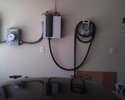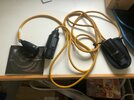I am in New York and have a 1.5 that is garaged and rarely driven. My charging objective is to do what is best to extend the life of its battery and the PEM.
I presently have the early mobile connector (yellow cable with GFCI like plug) and the earlier (not the Clipper Creek) HPWC for the Roadster. Presently I use the mobile connector on a 15 AMP 120 Volt circuit which charges the car at 12 amps. It has been working fairly well.
The car is rarely driven and garaged (no extreme cold or hot temperatures). I'd guess the a few days a year it could get as hot as 90F/32C in the summer and as cold as 25F/-4C in the winter in my garage, with most of the time much more moderate. I had heard that charging at 120 volts @ 12 amps only permits the fan, and not the air conditioner, to keep the battery cool, so I think there might be some benefit in either connecting the mobile connector to more than 15 amps, or using the HPWC @ 240 volts (or one of the other 240 volt ideas mentioned below).
I am considering having an electrician doing one of the following upgrades:
A) Install a higher amp 120 volt outlet to use with the mobile connector, so I can charge above 12 amps.
B) Install a 240 volt hardwire to my HPWC. Advantage to hard wire is it would keep the HPWC "original" as they are rare.
C) Install a 240 volt NEMA 14-30 (dryer) outlet. Similar to option B), but has the advantage of being a bit future proof if I want to use the 240 volt power for something else, like another EV.
D) Install either a Tesla or third party CCS home charger and use a "CAN" to charge the Roadster at 240 Volts. Means buying stuff I don't have, but will keep the Roadster's original mobile and HPWC unused which might help keep it in better condition in the future, as they are already somewhat sought after, and will be more so in the future (IMHO).
My home was recently upgraded from 150 Amp service to 200 Amp service (old breaker box was in poor condition), so I have plenty of Amp capacity for whatever I end up doing. I don't mind spending more money for something that is useful, but certainly don't want to spend a lot extra if it adds little value.
Please see pictures which I grabbed off other posts on TMC that show what I have, as I am not nearby where my Roadster is garaged.
If anybody has any documentation on my HPWC (see picture), I'd really appreciate it. Even if I don't end up using it, I'd love to have a PDF of its manual/specs to be able to refer to in the future.
I presently have the early mobile connector (yellow cable with GFCI like plug) and the earlier (not the Clipper Creek) HPWC for the Roadster. Presently I use the mobile connector on a 15 AMP 120 Volt circuit which charges the car at 12 amps. It has been working fairly well.
The car is rarely driven and garaged (no extreme cold or hot temperatures). I'd guess the a few days a year it could get as hot as 90F/32C in the summer and as cold as 25F/-4C in the winter in my garage, with most of the time much more moderate. I had heard that charging at 120 volts @ 12 amps only permits the fan, and not the air conditioner, to keep the battery cool, so I think there might be some benefit in either connecting the mobile connector to more than 15 amps, or using the HPWC @ 240 volts (or one of the other 240 volt ideas mentioned below).
I am considering having an electrician doing one of the following upgrades:
A) Install a higher amp 120 volt outlet to use with the mobile connector, so I can charge above 12 amps.
B) Install a 240 volt hardwire to my HPWC. Advantage to hard wire is it would keep the HPWC "original" as they are rare.
C) Install a 240 volt NEMA 14-30 (dryer) outlet. Similar to option B), but has the advantage of being a bit future proof if I want to use the 240 volt power for something else, like another EV.
D) Install either a Tesla or third party CCS home charger and use a "CAN" to charge the Roadster at 240 Volts. Means buying stuff I don't have, but will keep the Roadster's original mobile and HPWC unused which might help keep it in better condition in the future, as they are already somewhat sought after, and will be more so in the future (IMHO).
My home was recently upgraded from 150 Amp service to 200 Amp service (old breaker box was in poor condition), so I have plenty of Amp capacity for whatever I end up doing. I don't mind spending more money for something that is useful, but certainly don't want to spend a lot extra if it adds little value.
Please see pictures which I grabbed off other posts on TMC that show what I have, as I am not nearby where my Roadster is garaged.
If anybody has any documentation on my HPWC (see picture), I'd really appreciate it. Even if I don't end up using it, I'd love to have a PDF of its manual/specs to be able to refer to in the future.




